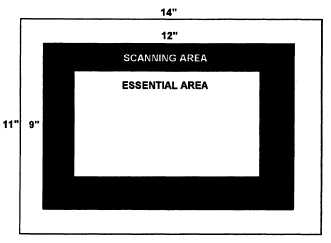information from either the top or bottom, or its sides,
and visually, it would look poor on the television screen.
Scanning Area
The total area seen by the camera is called the
scanning area. This image is transmitted fully, but the
outer edges and the corners usually do not appear on the
home television set because of the shape of the picture
tube. A properly aligned television receiver will display
all scanned information at the top and bottom center of
the picture, but will crop corners because of the
nonsquare corners of the picture tube.
The common mistake many new television
broadcasters make is allowing too much headroom at
the top of the picture. Remember: the home receiver sees
everything at the top center, so do not overcompensate
the same way you do for edge and comer cropping.
Essential Area
The portion of the picture that reaches the viewer
must include all of the important information — this is
known as the essential area. All visuals have a scanning
area and an essential area. The scanning area is the entire
picture from top to bottom and from side to side. The
essential area is the meat of the picture — the main
information within that picture area. Both the scanning
and essential areas of a picture are shown in figure 14-14.
Border Area
The border area is another important area of the
television picture. Graphic artwork should have a border
around the scanning area for the following reasons:
1. It helps prevent the picture from being damaged
if dropped.
2. It helps protect the artwork from fingerprints
and smudges.
3. It may prevent your audience from seeing past
the card to some behind-the-scenes activity if the
camera operator did not have time to frame the shot
properly.
4. It serves as a “bleed-off’ area for overscanned
sets. The excess border contains no essential
information.
Size
There is no specific size of studio title cards or other
television visuals. However, a generally accepted size is
11 by 14 inches. It is best that all visuals be made the
same size for storage purposes. The 11- by 14-inch size
fits well in a standard file cabinet. The cards should be
numbered with a piece of marking tape on the edge.
Stagger these tabs for easy access.
A visual that is 11 by 14 inches offers the following
advantages:
1. It allows an ample 2-inch handling border so
fingerprints and smudges will not damage the primary.
information.
2. It leaves a 9- by 12-inch working area for both
the camera operator and artist.
3. It is compatible with the aspect ratio requirement
of 3:4, thus incorporating a measure of safety.
It is also wise for you to mark off an additional 10
or 15 percent inside this 9- by 12-inch area. Your doing
this will give you a copy area of about 7 1/2 by 10 inches
and compensates for the picture area lost because of
cropping (transmission loss) on the home television
receiver (fig. 14-15).
Figure 14-14.—Scanning and essential areas of a television picture
14-15
Figure 14-15.—Transmission loss.



